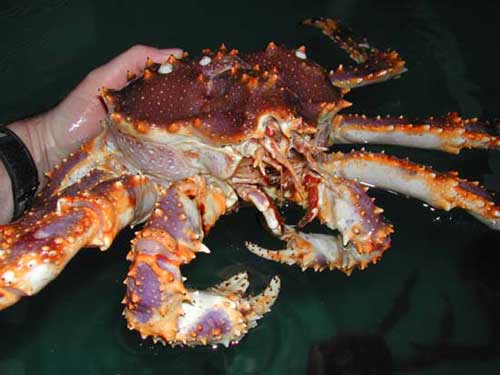 September 03, 2004
In 2003, the North Pacific Research Board funded the first of three years year of blue king crab research by Dr. Bradley Stevens, Sara Persselin, and Julie Matweyou at NOAA's Kodiak Fishery Research Center.  Photo by Scott Van Sant, courtesy NOAA
"All our research on blue king crabs larvae is based on what we know of red king crabs," said Persselin. "More research has been done on red king crabs than blue. Since we have raised red king crab larvae successfully in the lab the last few years, we are applying those culture techniques to the blue king crab larvae." The project's goal is to discover methods for raising blue king crab larvae in the laboratory. Research focuses on experiments in diet, water temperature and rearing density of blue king crab larvae. Persselin mentioned that the rearing experiments do not duplicate the environmental conditions of blue king crabs in the wild since copying such situations would be extremely difficult. "If we can successfully produce large numbers of small crabs, we can use them for future research on settlement behavior, habitat selection, and other aspects of their biology. " said Dr. Stevens. "Our techniques might also be adapted, someday, to large scale culture of juvenile crabs for release into the ocean in order to enhance natural stocks that have been depleted." Blue king crabs have a reproductive cycle that lasts a year longer than red king crab. The first year a female blue king crab will molt before mating and developing the eggs. The eggs are then carried on her abdomen until the following year when the eggs hatch and the larvae swim away. Blue king crab females do not mate again until the next year, creating a two-year reproductive cycle The habitat range for blue king crab extends from the coast of Hokkaido, Japan into the southern Bering Sea and south along the Gulf of Alaska. A small population of blue king crab also inhabits the southern end of Kodiak Island. In the past, Pribilof and St. Matthew Islands supported the largest stock of blue king crab in the world. According to the annual NOAA Fisheries trawl survey, blue king crab abundance in the Pribilof Islands has declined almost continuously over the past 10 years. All blue king crab fisheries have been closed since 1997. The survey abundance index for the population fell from 8.4 million crab in 1996 to 4.4 million in 1998, to 2.2 million in 2000 and only 1.4 million in 2003. The 2004 index of 0.3 million crab was the lowest on record (1994-2004). The St. Matthew Island population has fared only slightly better falling from an index of 10.0 million in 1996 to a record (1978-2004) low of 1.2 million in 2001, but recovered to 3.3 million in 2003 and was 2.7 million crabs in 2004.
Source of News & Photograph:
|